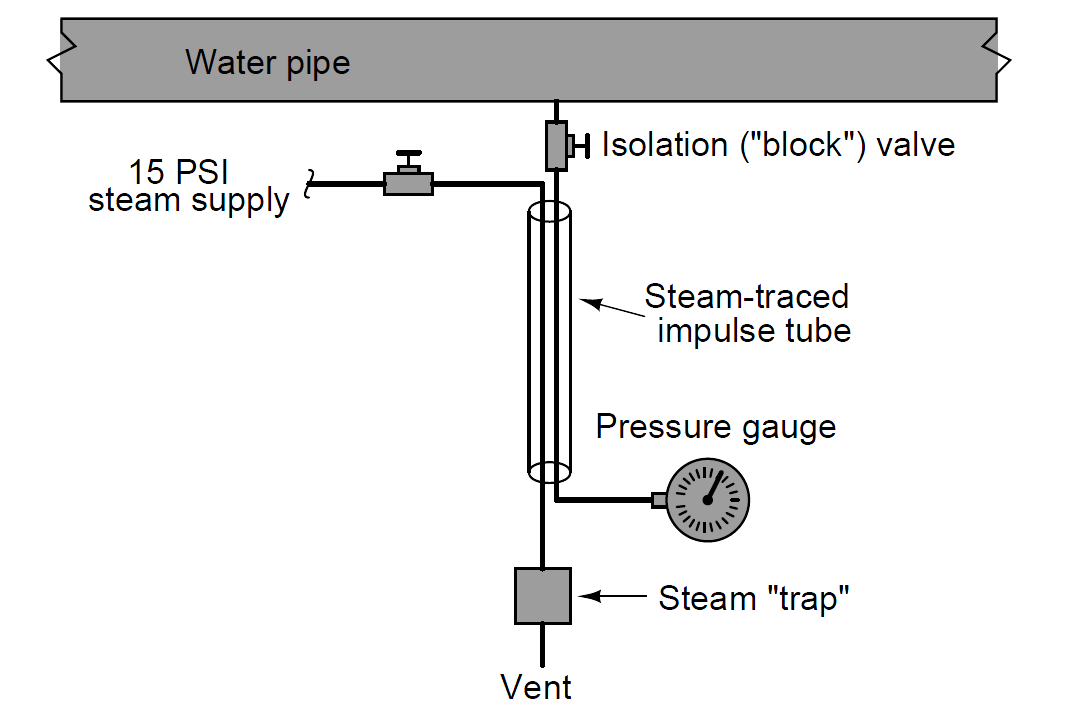If impulse lines are filled with liquid, there may exist a possibility for that liquid to freeze in cold weather conditions. This possibility depends, of course, on the type of liquid filling the impulse lines and how cold the weather gets in that geographic location.
One safeguard against impulse line freezing is to trace the impulse lines with some form of active heating medium, steam and electrical being the most common.
“Steam tracing” consists of a copper tube carrying low-pressure steam, bundled alongside one or more impulse tubes, enclosed in a thermally insulating jacket.

Steam flows through the shut-off valve, through the tube in the insulated bundle, transferring heat to the impulse tube as it flows past.
Cooled steam condenses into water and collects in the steam trap device located at the lowest elevation on the steam trace line.
When the water level builds up to a certain level inside the trap, a float-operated valve opens to vent the water. This allows more steam to flow into the tracing tube, keeping the impulse line continually heated.
The steam trap naturally acts as a sort of thermostat as well, even though it only senses condensed water level and not temperature. The rate at which steam condenses into water depends on how cold the impulse tube is.
The colder the impulse tube (caused by colder ambient conditions), the more heat energy drawn from the steam, and consequently the faster condensation rate of steam into water.
This means water will accumulate faster in the steam trap, which means it will “blow down” more often.
More frequent blow-down events means a greater flow rate of steam into the tracing tube, which adds more heat to the tubing bundle and raises its temperature.
Thus, the system is naturally regulating, with its own negative feedback loop to maintain bundle temperature at a relatively stable point.
The following photograph shows a picture of a steam trap: Steam :
Steam traps are not infallible, being susceptible to freezing (in very cold weather) and sticking open (wasting steam by venting it directly to atmosphere).
However, they are generally reliable devices, capable of adding tremendous amounts of heat to impulse tubing for protection against freezing.
Electrically traced impulse lines are an alternative solution for cold-weather problems.
The “tracing” used is a twin-wire cable (sometimes called heat tape) that acts as a resistive heater. When power is applied, the cable heats up, thus imparting thermal energy to the impulse tubing it is bundled with.
This next photograph shows the end of a section of electrical heat tape, rated at 33 watts per meter (10 watts per foot) at 10 degrees Celsius (50 degrees Fahrenheit):
This particular heat tape also has a maximum current rating of 20 amps (at 120 volts).
Since heat tape is really just a continuous parallel circuit, longer lengths of it draw greater current. This maximum total current rating therefore places a limit on the usable length of the tape.
Heat tape may be self-regulating, or controlled with an external thermostat. Self-regulating heat tape exhibits an electrical resistance that varies with temperature, automatically self-regulating its own temperature without the need for external controls.
Both steam and electrical heat tracing are used to protect instruments themselves from cold weather freezing, not just the impulse lines.
In these applications it is important to remember that only the liquid-filled portions of the instrument require freeze protection, not the electronic portions
Credits : Tony R. Kuphaldt – Creative Commons Attribution 4.0 License
Learn an example PLC program to control a pump based on level sensors using ladder…
In the PLC timer application for security camera recording, when motion is detected then camera…
In this example, we will learn batch mixing with PLC ladder logic program using timer…
This PLC example on manufacturing line assembly is an intermediate-level PLC program prepared for the…
In this article, you will learn the PLC programming example with pushbutton and motor control…
This article teaches how to convert Boolean logic to PLC programming ladder logic with the…
View Comments
For better steam traccing ,steam traccing tube to be rounded with impulse line then its insulated with glass wool .